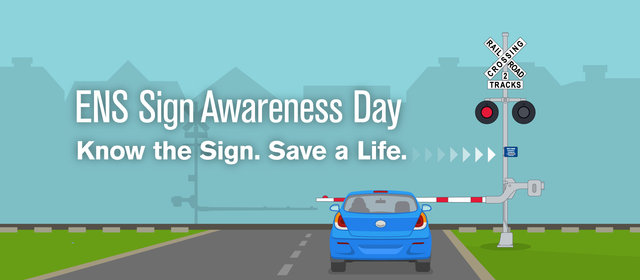
June 25, 2025
Know the Sign and Make the Call to Prevent Tragedy
June 24 is the first-ever ENS Sign Awareness Day, launched by Operation Lifesaver, a national rail safety education nonprofit. When seconds count, knowing how to use this sign can make all the difference.
A Direct Line to Safety
You may have noticed them, those blue-and-white signs posted at railroad tracks. But what many people don’t realize is that they’re more than markers – they’re a direct line to help.
Each ENS sign has two key details: a phone number that connects to the railroad’s emergency dispatch center and a unique crossing ID number that tells dispatchers exactly where the issue is.
Whether it’s a stalled vehicle, a signal issue or debris on the tracks, calling the number on the ENS sign connects you to someone who can take action. When time is critical, that can make all the difference.
Everyone Has a Role
Through UP CARES, Union Pacific’s safety outreach program, and in partnership with Operation Lifesaver, I’ve had the opportunity to talk to thousands of first responders and community members in classrooms, city halls and community centers. Across all these audiences, one message holds true: rail safety is a shared responsibility.
Every day, drivers, bicyclists and pedestrians traverse the more than 212,000 railroad crossings nationwide. When something goes wrong, the first person on the scene isn’t always a first responder—it could be you. ENS signs give you the power to take action when it counts.
What to Know, What to Do
On ENS Sign Awareness Day, I hope you’ll take a few minutes to learn:
- What it is: A blue-and-white sign near railroad tracks.
- What it shows: A crossing ID and emergency number.
- Why it matters: It links you directly to railroad dispatchers.
- When to use it: If something’s blocking or failing at the crossing.
- What to say: Provide the ID and describe the issue clearly.
One Sign. Big Impact.
ENS signs empower everyday people to make life-saving decisions. They’re not just signs. They’re tools for public safety. And that’s why this day—and this message—matter.
When communities know what to do, they’re safer, and when we give people the tools to respond, we give them the ability to help.
Let’s make sure everyone knows the sign.
—
Buck Russel is a senior supervisor of Public Safety for Union Pacific Railroad and a volunteer presenter with UP CARES. He has 28 years of railroad experience and has trained communities across the country on railroad safety.